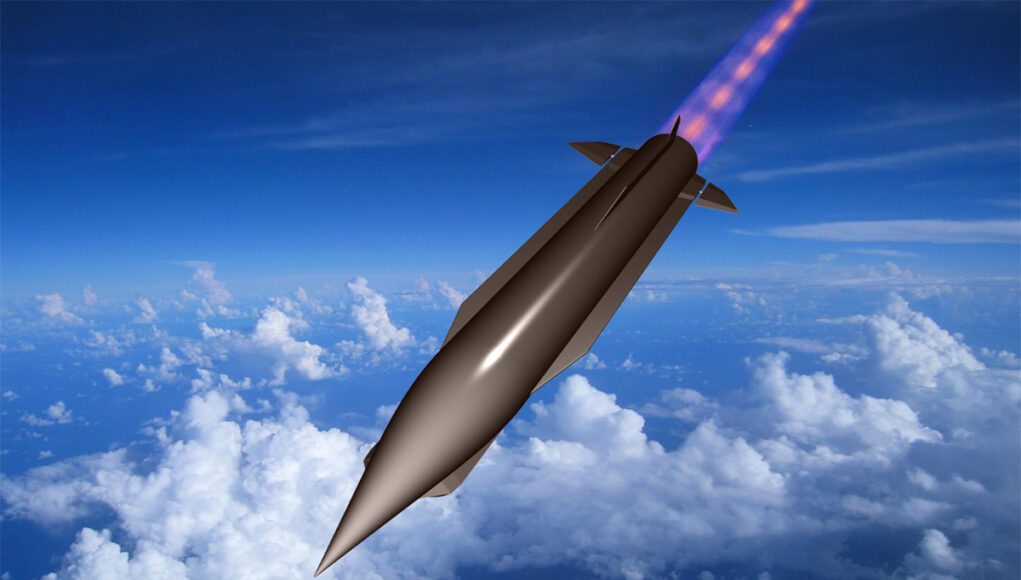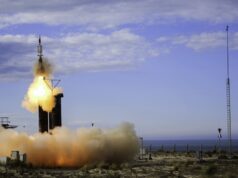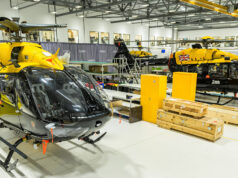Britain’s development of a sovereign hypersonic strike capability is taking a substantial leap forward with a new agreement to facilitate collaboration on cutting-edge technology.
Ninety organisations – large and small – from across industry and academia have secured a place on a £1 billion transformational Hypersonic Technologies & Capability Development Framework (HTCDF) agreement set up to rapidly develop advanced hypersonic missile capabilities for the UK.
The organisations accepted onto the eight-lot Framework, which is led by MOD’s Team Hypersonics (UK), will now be eligible to bid for contracts; the maximum value of the Framework across the next seven years is up to £1 billion.
According to a press release: “The award of contracts on the Framework will be managed by commercial experts at DE&S. Project delivery has been designed with pace in mind, with the Framework adopting mechanisms which align procurement and development objectives, preventing the traditional challenges that impede capability acquisition. The approach to developing an agile route to market is part of a broader drive across MOD to increase the speed of defence procurement.”
Team Hypersonics (UK) Programme Director Paul Wilson said:
“We had a fantastic response from those wanting to be part of what is an iconic national endeavour. In an unsettled world, the battlespace is continually evolving, and the UK MOD recognises the need for agility to ensure we can rapidly develop and deliver the capabilities our Armed Forces need to protect our interests and those of our allies.”
The Framework was announced late last year after the UK Government indicated its intent to accelerate the development of a sovereign UK Hypersonic Strike Capability, whilst bolstering AUKUS collaboration with Australia and the United States.
“The HTCDF has been designed to provide a responsive, agile route to market to facilitate capability realisation at pace. Uniquely it will be used to select suppliers to deliver services and supplies to support the research, development and testing of hypersonic technologies right through to a capability.
Intrinsically linked with MOD’s ambition to transform acquisition, the Framework enables focussed research to be spirally developed through varying Technical Readiness Levels (TRLs) onwards to a capability. The maturity of the services and supplies provided under the resulting Call Off contracts will be TRL 1 – 9.
Alongside established weapons manufacturers and academic institutions, nearly half of the suppliers will be Small and Medium Enterprises (SMEs), the vast majority of which are based in the UK. This diverse supply base will enable MOD to leverage the strength and breadth of UK and international talent and innovation across the defence enterprise.”
Minister for Defence Procurement, James Cartlidge said:
“Hypersonics will be a landmark capability of the future and it is essential we keep pace with the developments of our adversaries. The Framework sends a clear demand signal to UK industry of our intention to develop hypersonics, which is critical for the nearly 50% of the suppliers which will be Small and Medium Enterprises (SMEs).”














Good news. Nice to know we’re planning to start producing these in seven years, whilst Russia is busy lobbing them at Ukraine now and even North Korea claims to have them.
Would someone please give me an insider’s explanation as to why we are so late to the party on this one? My pessimistic gut instinct is Western arrogance, assuming Russia and China weren’t really capable of doing everything they were claiming and justifying our inaction on the basis of some arrogant sense of intrinsic superiority.
Any missile that goes above Mach 5 is “hypersonic.” That includes ballistic missiles like the WWII German V2, the Trident missile… Russia just straps an old ballistic missile to an aircraft, fires it and calls it a “hypersonic missile.”
In reality a modern hypersonic missile should be smart, taking evasive action, changing altitude, doing things the decades old Pershing II did.
This is about creating a modern hypersonic missile not the Kremlin propaganda definition.
yes you can tell your UK government to build a hypersonic toy for the display on New years fire works…Its impossible for UK to build this hypersonic as they were late of developing this. The mighty Russians and China are ahead of doing these a long time ago with their advanced technology and greatest scientist ever! Tell your UK friend to stop dreaming and better buy hypersonic to China for UK defence system.
Yes but they are all lying, only the US has anything close to a real hypersonic weapon. The Russia definition would mean the nazi’s were firing hypersonic weapons at London in 1944.
That’s interesting 🤔. I thought they’d progressed the glide type vehicle. So, presuming we’re aiming for something more like a cruise missile then we’re not so far behind.
Yes Jim is fundamentally correct, ‘hypersonic’ has something of the 5th or 6th Gen military aircraft about it whereby it’s easier to assess in retrospect than it is to determine beforehand and originated as a pr campaign to get US Govt business on the perception of being superior to the competition and create fear that others might get there first.
And that is what happened with hypersonics as a ‘new’ category for though it represents a speed which has as we know been attained in missiles since WW2 this nebulous new category means rather more, though undeniably different things to different people in reality. So the Russians for reasons of propaganda call the Kinzhal hypersonic despite being merely a bit faster version of a Soviet design with the limitations inherent in that and so really only meets the long existing speed aspect of the term, it’s purely image over reality esp as it’s not hypersonic in its final phase it seems. Zircon has a similar legacy by some accounts and there are doubts about what’s claimed about it as Russian released film doesn’t suggest it’s a true hypersonic missile either in the modern sense. Only Avangard looks the real deal in appearance (design is vital in a true Hypersonic missile of the modern use of the term) as it’s a glide vehicle and can manoeuvre if performance meets looks.
Now the US was years ahead of anyone else having had research and even test vehicles in the development of modern hypersonics, military and otherwise going back decades. However a decade + ago funds and the belief that the cost v perceived threat did not add up and their perceived advantage in question especially as no one else had them or it was thought would have then any time soon, so all development beyond conceptual pretty much stopped, while it seems without western knowledge (or was it disdain) Russia and especially China persisted and on paper caught up and some would say surpassed the US. However that’s because they have fielded them while the US’s overwhelming knowledge base simply remained untapped till recently when they woke up to a potential threat to their existing defences and re-invigorated actual physical programmes. The programmes that have now been reignited however are far superior (again on paper presently mind) than those of a Russia and very likely China too though that’s a little more tricky to determine and no doubt t they are pushing very hard we know little about in reality, however you can’t simply catch up on decades old knowledge and experience in the lab as their engine and airliner efforts show. The US is going to have a very wide range of missiles however and at the top end will be the best around no doubt. They were truly a sleeping giant in this technology it’s what they want to invest in it to bring numerous designs to fruition that’s the major question no doubt.
Thanks for that useful and interesting update.
No if they go it alone they are a very long way behind, AUS and US have been developing HACM (hypersonic airbreathing cruise missile) since the 90’s through the joint hifire and SCIFIRE programs. Assuming the UK will use AUKUS to leveredge the technology for a quick boost on the technology
Because there was no expressed Customer requirement, it will be very expensive, includes technologies that have not been matured in the UK and until recently no significant funding was available. Not sure that ‘Western arrogance’ features. China is capable of a lot. They may put the next person on the moon. Do not under-estimate them.
7 years is very hard to believe, I do not.
Thanks for the feedback.
What has suddenly focussed the minds of those in power, why this somewhat sudden change?
Well simply that potential enemies are beginning to field such weapons, be they effective or otherwise presently fact is technology will get them there eventually, so inevitably the West has to restart efforts that cost, especially in maturing the technology has to be borne, simply to make sure we are not at a disadvantage in the future. It was deemed a decade or so ago these sort of weapons had disadvantages and challenges that with the great cost involved offered little to no advantage in an environment that was still deemed in peace dividend mode. That has now been shattered and the expense of getting on the escalator is now no luxury even if its years from being realised or the threat an actual potential war winning one.
Out of interest the UK flew a quantum guidance system in an airliner recently and I suspect such technology could be a serious advantage to a hypersonic missile whereby the plasma bubble it creates plays havoc with traditional targeting techniques or gps. So a problem that seemed a massive barrier for accurate and manoeuvrable hypersonic missiles may now seem far less of a barrier to future platforms.
To be honest..it may simply be that…you don’t need hypersonic missiles or that they are not perceived as the game changer..so there was less call to plow in billions….in reality it’s the thing you cannot see or target that kills you…not the blazing fast thing that screams I’m coming for you…the west is also very very focused on accuracy and reducing collateral damage…generating huge amounts of kinetic energy is not conducive to being either stealthy, accurate or developing lower levels of collateral damage….things the west cares more about than say Russia or china…
it’s the same with supercavitation torpedoes…Russia has made torpedoes that can travel at 230mph..compared to the wests fast 70-80mph torpedoes…..one is a bad idea that’s useless the other is a killer.
You are fundamentally correct, a decade ago it simply was not felt the cost was worth it for arguable advantages but firstly when the opposition is fielding them you have to respond (just in case) and secondly technology is developing that suggests their disadvantages may in fact be overcome and in a not too distant future indeed, so that cost value equation changes and the ‘just in case’ becomes ‘good job you did’.
one other thing the US is actually experimenting to determine if the plasma bubble can actually be used as a stealth effect in its own right though have no further details.
Indeed, these things are ever changing…it’s knowing when you need to move or something becomes a must have…or ensuring your counter is up to scratch…fast missiles vs slow missiles has always been one of those areas where it’s hard to see…what’s better a profoundly accurate and stealthy slow missile or a less stealthy..less accurate very fast missile…obviously if someone comes up with a very accurate, very stealthy very fast missile that’s as cheap to produce as other solutions then it becomes easy….but while the technology base ( and physics) leads to compromise it’s a less easy question….sort of like the whole…armour vs mobility vs firepower question that has always dogged tank design). Although the question is actually..strategic mobility, vs tactical mobility, vs anti tank firepower, vs infantry and anti material firepower vs armour vs cost vs supply and logistics…..there is never a silver bullet and competing compromises always lead to different solutions…( it’s like asking what is better a Burke or a T45…neither as it’s the wrong question to ask).
Other priorities ?
Probably unlike Russia, Iran, and North Korea the West had no long-term plans for an offensive war of scale against near-peer industrialised nations.
We should have been more vigilant, there were signs as far back as far as 2008 that Putin was gearing up for another large war.
Kinzhal is just an air launched ballistic missile
Why spend a billion pounds on developing this instead of say buying off the shelf from the US? We waste money on trying to re-invent the wheel only to find we can only afford to purchase a tiny number of whatever it is we end up with?
I’d just order £1 billions worth of TLAM.
650 or so of those is more effective than what would end up being a few dozen hypersonic. If it ever came to anything what so ever – which it obviously won’t.
Or another 500 Stormshadow.
I am so with you on that. A big buy of the new fcacsaw or whatever would deliver more effect surely. However, do we have the platforms to launch large?
Buy more P8 and hang these things off them (as a suggestion).
AA
Why do we want our money to fund them rather than British jobs and expertise? The US hasn’t supplied cruise missiles to Ukraine. We make Storm Shadow, so we are free to give it away.
What Hypersonic Strike Missiles have the Americans got on the shelf?
None, at least not publicly acknowledged. They do have a number of programs that have gone through extensive developmental testing and the LRHW appears very close to being declared operational.
Exactly, they are years ahead of us in developing a weapon that’s anywhere close to becoming operational, no point in us wasting billions trying to catch up!
Yes but it might well be that within a decade or two nearly all major missiles will be high supersonic to hypersonic so you might be taking yourself out of the forefront of missile design if you do that, or become very uncompetitive. The Israelis are developing a hypersonic anti hypersonic missile system so it’s not like only a few of the richest Countries can engage in it. I suspect hypersonic missiles will be very common in the next decade hell I mean Starstreak is already close in speed so yes while certain aspects of hypersonic missile development might be a tough nut to crack other aspects are pretty easily attainable. But either way to get into partnerships you need something to offer and for the Country that devised some of the glide vehicle concept decades ago it would be foolish not to be involved at some level at least and thus research is vital.
None on the shelf yet, but there are several lines of effort. The US is working hard and spending a lot of money on several hypersonic programs of different types.
The US Army and USN are developing the Conventional Prompt Strike hypersonic glide vehicle weapon that will go in Army ground launchers and the Navy’s Zumwalt class destroyers. The Navy bought 10 CPS in last year’s budget, it’s still under development though, and the Zumwalt are getting launchers for them right now.
The USAF is developing Scramjet type hypersonic cruise missiles like the ARRW and HACM with different levels of success so far, but progress is being made. ARRW seems to be on again-off again, but is still a valuable development effort.
The Navy is developing the HALO, an air-launched weapon. HALO might not actually be “technically” hypersonic, but perhaps high supersonic. It needs to be small enough to fit on USN strike fighters and fit on CVN weapons elevators, so the USN is willing compromise a bit on speed to have a “fast enough” weapon that they can actually use on carriers. The LRASM was developed as an interim weapon for the F/A-18 Super Hornet till the HALO comes on line.
Lockheed Martin just announced a supposedly hypersonic weapon called the MAKO, that can fit in the weapon bay of F-35As and Cs. Like the others its still developmental. It is a more traditional looking missile and is neither a glide vehicle nor a scramjet. It lost out in a USAF competition for the Stand In Attack Weapon (a non-hypersonic variant of the AARGM-ER won). I don’t know if MAKO has an actual budget line item yet, but LM is looking for a buyer.
Because it gives “pork” to our defence industry? Seems to be the priority for HMG most of the time defence wise.
To an extent true…but weapons research and develop as well as funding how technology can be applied is important…it’s just one of those things you do have to throw money at..if you want to stay ahead…But it needs to be a balanced thing and you actually need to be managing now as well as investing in the future..at the moment we are not managing now very well…
I also agree hypersonic strike needs to be a collective thing the west does….as it’s not something one nation will need to be vastly different from the next…it’s also not going to be profoundly critical…
I thought France and Australia were already working on these programmes too? Perhaps we could partner with them?
Have no idea about france but AUS and US have been joint developing HACM since the 90;s under the HiFire and SCIFIRE program. Allegedly getting close to final design, with rumored firing of test missiles to be done in AUS as early as late this year
Well that was said about space launch vehicles two decades ago indeed That her thought trying to compete with Boeing on airliners or NASA on space launch vehicles was madness. How things change while it’s true Ariane has been a waste of money and effort for the most part if only because it was heading down a dead end (though successful as a technical launch vehicle in its time just too costly), fact is producing launch vehicles now is relatively cheap and attainable to all and Britain remains as the only Country to actually give up such a capacity and even New Zealand capable of producing one. Things move on and what was prohibitively expensive even a decade ago may well be taken for granted a decade in the future, timing is everything. But you don’t time it right by only commuting once everyone else has done it you have to have vision and the lack of that is why British Industry was so mauled over previous decades.
Losing the capability, researchers and knowledge we had with what was a seriously advanced and fundamentally successful rocket in Black Knight was painful, at least we can learn from that and fact is the waverider principle of hypersonic manoeuvrable flight was invented in this country way back when we still had a space programme and another concept exploited by the US and others. Meanwhile our present space industry though little supported by Govt is extremely efficient and innovative returning much more per £ or $ than the massive US version. Indeed we are brilliant at innovation on a budget, I guess we have to as there is so little faith in it from Govt and institutions, because it’s seen as too risky or expensive. That’s why we far too often fall so far behind even on things we conceptualise and once we see the financial potential it’s usually too late.
I hope someone has had the sense to include I Reaction Engines in the partnership. Their air breathing rocket tech could be a useful and less risky route to hypersonic speed than a Scramjet. Plus it works from 0 mph. No booster required to get it up to speed first.
Reaction Engines is already involved with Rolls Royce in the Hypersonic Air Vehicle Experimental (HVX) Programme.
Good their Sabre engine tech is getting recognition
Also with the mythical project of Skylon
Well that was only a conceptual use of the Sabre engine to focus minds and until the actual engine is proved as a whole it’s difficult to build an actual airframe around it, certainly a space plane one which at best is always going to be a borderline capability when exploiting single stage to orbit. Considering DreamChaser only just about got off the ground and is a massively less complex a platform with known engine technology Skylon was always going to be a far flung possibility as yet the main purpose of which was to get people thinking about how they might use the Sabre and technology demonstrated within it, which the company itself has admitted. HVX as innovative as it is is a far more sensible proposition though still mostly advanced research rather than an actual physical proposal as such yet, whatever the pr might suggest, again it’s to assess if, as and when such a project might come to fruition and the technologies required to do so. US and Canadian efforts towards a hypersonic plane are making progress and not run by giant aero companies, which is probably a good thing seeing the mess the likes of Boeing make of big projects.
It also seems Reaction Engines are well on the way to prototyping a complete engine having proved the individual elements in recent years.
I would not call it mythical. They are not into building airframes but they are well towards their air breathing rocket engine. The heat exchanger is an amazing development with many applications including conventional gas turbines
Yes it’s going to be very competitive in that sector American companies are producing hybrid designs too but presently they look like mash ups compared to the beauty of the Sabre. That said the rotary detonation engine combined with a Ram/Scramjet looks like it has great potential in this low/high speed conundrum. Main problem is that jet turbine engines start to fail over a cliff at speeds well below where Ram/Sram jets start to operate efficiently. But shows, like Bond at Reaction did, you have to have great faith in future markets and see a potential opportunity, which is why you have to invest in technology and ideas sometimes at great cost long before most (as with some on here too) see the future benefits and opportunities. It’s too late to play catch up unless you can later find a big technological advantage you can apply to others ideas.
Seems sad to me the first rocket to launch from the UK, indeed Europe will be German because they committed to an opportunity and got Govt support much quicker than the UK did even though innovative designs like Skyora were working hard themselves on pushing ahead. Perhaps it’s ironic that another Company calls itself Black Knight, so at least some recognise lost historical opportunities.
And I note DSTL have stated the following regarding HVX and Reaction engines core role in this programme:
“… we are exploring potential operational utility of these concepts; maximising exploitation of the wider S&T Portfolio, such as the Hypersonics Weapons Research Programme.”
Better spent buying “mass”. These clown like programmes are mere propaganda anyway.
This is what the UK need to do more of really ,best to be capable rather than buying from other nations.Even our USA friend’s ,to be honest even the yanks don’t give us all there Tec and that goes for the F35b .It’s a case of make do with what we Allow. 🤔🇬🇧 🇺🇸🤗
It’s a balance for me. Yes we need sovereign. But in all areas? Would that billion have been better spent on a good enough rather than the R&D for hypersonic?
What will the military actually get for that outlay?
Could that money have gone towards a LRASM for our jets for example? Or any glaring capability gap.
In complete agreement. In US doctrine at least , hypersonics don’t replace other ballistic or cruise missile and have a much smaller and specific use case. IMO this is more of chasing the next shiny thing than actually improving overall war fighting capability.
Well yes, researching something you have no capability or capacity to produce en masse is wasteful.
That’s the thing DM, getting the right balance in the past has been some what wanting .He’s hoping 👍
Agreed..what industries are vital and what can make use money and finally what do we trust to just buy off the shelf from another nation…
I do think the priority should be the airo industries, ship building,submarine building, basic munitions and complex munitions ( they type you need to fight a peer war) Infantry fighting vehicles would be nice to have as well…
The problem is you never know when your allies will have a funny turn and not sell you something…classic example is the F22..and also the Ukraine war.
I’d add the EW, Cyber, ISTAR, Sonar, Radar fields mate.
Yes indeed. Very true.
We should also be focusing on expanding our export potential, its ok to buy foreign in some instances, Helicopters are a good example of this. But we can still push out in other areas. Dragon FIre and the quantum positioning system in development are great opportunities to equipe all our allies globally. Just hope we don’t give these away through co-op agreements that see the IP lost.
We also need to remember that our RnD into stealth gave us a good seat at the F35 table, BAe,s work on Replica was seen as a threat to US dominance of the 5th gen fighter market.
Ron offered Maggie the F22 but it was declined on the grounds of cost. Nobody expected stealth to be so expensive. Thus UK has no stealth bomber fleet: B1B, B2, B21…
Hi he may have done..but in 1998 congress passed a law that specifically forbade any export of f22 to any nation….therefore dooming what is undoubtedly the best fighter ever built to a niche role and early death…as the 100+ airframes built are gradually cannibalised for spares.
I’m of the view we should focus on things we’re good at and have upside for economy also. We’ve squandered RnD money in the past making unafordable unexportable defence kit. We need to focus on some areas and develope it into an exportable products. We need accept some things we’ll never build or develop but that will be offset by exporting of what were good at. If we can export more than we buy in then we’re defending country physically and economically.
We might as well look into the new Lockheed/Co. aspire Mako (Multi-Mission Hypersonic Missile), a stand-off hypersonic missile that can fit internally of an F-35. It doesn’t mention if it’s a glide vehicle of cruise hypersonic cruise missile.
Information seems limited and certainly worth a look, but I think it’s more a very fast strike missile towards the bottom end of what might be classed a ne t Gen hypersonic missile, I don’t think it is a sophisticated glide vehicle which tend to be rather larger and have a distinctive look beyond what might be a traditional boost stage. That’s not going to fit in an F35 bay but it might still have manoeuvrability at high speed but as I say details seem limited at present unless others have seen something more of late.
Not directly related but relevant in time, I read yesterday that scientists in the field are now estimating when they expect ASI (Artificial Super Intelligence) believing that the moment we have AGI (Artificial General Intelligence) and some believe that has been achieved at OpenAi and/or others already that ASI will follow quite quickly. Many believe the main stumbling block is actually server space and the necessary information pipelines. Basically it would be at the point, as predicted by Turing whereby once Ai matches or surpasses human intellect technological development will progress at a rate never seen before. Indeed we have seen indicators of this at DeepMind where an Ai it has developed has already predicted a number of new potential molecular combinations for new materials in the thousands of which nearly a hundred seem to have potential to be created and possess practical applications.
Anyway the point is the estimates these scientists predict for ASI is between 2027 and 2030, the former deemed optimistic the later as very likely. Ignoring for the moment the very scary matter of how we, while not fully understand what this intelligence might be up to revolving around ethical compliance, some claim that the first Organisation to achieve this will effectively ‘control’ all that follows because by the nature of that evolving intelligence others won’t be able to catch it up, so that Organisation or Govt becomes Master of the future. That may or may not be but what it means is in getting back to this thread is that such an intelligence will be able to advance weaponry development existentially compared to what we can do now and one presumes only the richest (with perhaps least moral intent) will be able to take advantage of that potential advance. Sounds like the nuclear era on steroids potentially and one presumes knowing that China will be committed to it the US won’t hesitate either. Where does that leave the rest of us I wonder, maybe AUKUS for one might be more important than we presently imagine.
As we have seen in Ukraine – it’s not just the capability of new weapons it’s being able to make them at scale, and at the right price so that you can afford to buy enough of them to make a difference.
Exactly. As has been suggested. Buy instead 600 TLAM and 500 fscw..fsac..fwsc or whatever. More effect? AA
Presume this is in addition to the £billion to be spent on FC/ASW
Why doesn’t the UK just pinch the plans of an existing Hypersonic a-la-Harrierski or Concordski per the Russians? The Soviets were masters of the copycat arts with several British and American designs especially in and around the 1960s
I’m just asking… I assume these missiles will be multi role, multi purpose?
Once again no sense of urgency from MOD. We could end up in a shooting war with Russia at any time. It will only take an error on either side to create conditions for a strike against UK targets. Time for us to catch up as change is moving at a rapid pace. Who would have predicted three years ago that Ukrainian Techies would pop down to Argos, buy some commercial drones, clip mortar bombs under them and then drop them down the hatch of Russian AFVs? Imagine how MOD would have dealt with that idea?